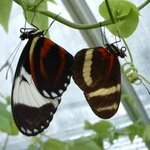Evolution

In the late 19th century, classification of humans was in vogue and a lot of it was done based on languages and physical characteristics. Physical anthropology and ethno-linguistics created the Aryan classification among Caucasians, meaning people of Europe and western Asia whose language descended from a common root and who shared physical/biological characteristics also.
The term Aryan became common among scholars of the day and science-fiction author H.G. Wells, a famous progressive eugenics proponent, popularized it in his best-selling The Outline of History, though it had been criticized…

Where do new genes come from?
It's a long standing debate in evolutionary biology but a new paper in Science Express says that new genes are created from non-coding DNA, and more rapidly than expected.
In a well-known model proposed by Nobel laureate Susumu Ohno, new functions appear when existing genes are duplicated and then diverge in function. David Begun, professor of evolution and ecology at UC Davis and senior author on the paper, says his laboratory discovered a few years ago that new genes could also appear from previously non-coding stretches of DNA, and similar effects have…
"Adam", our most common male ancestor, walked the earth 209,000 years ago, 9,000 years earlier than previously believed and within the time frame of his other half "Eve", the genetic maternal ancestor of mankind, according to a new paper.
Writing in the European Journal of Human Genetics, Dr. Eran Elhaik from the University of Sheffield and colleagues also take the opportunity to blow up some other research, such as the discovery that the Y chromosome predated humanity (the A00 lineage) and originated in a different species through interbreeding, which dates "Adam" to be much older.…

How did we get limbs from ancestral fish fins? It's a fascinating topic, a science enigma.
Our first four-legged land ancestor came out of the sea about 350 million years ago. Watching a lungfish, our closest living fish relative, crawl on its four pointed fins gives us an idea of what the first evolutionary steps on land may have looked like. However, the transitional path between fin structural elements in fish and limbs in tetrapods remains elusive.
Both fish and land animals possess clusters of Hoxa and Hoxd genes, which are necessary for both fin and limb formation during embryonic…

Species living together are not forced to evolve differently to avoid competing with each other, a notion that that has been debated since the early days of natural selection.
By focusing on ovenbirds, one of the most diverse bird families in the world, a team conducted the most in-depth analysis yet of the processes causing species differences to evolve. They found that although bird species occurring together were consistently more different than species living apart, this was simply an artifact of species being old by the time they meet. In fact, once variation in the age of species was…

A new hand bone from a human ancestor who roamed the earth in East Africa approximately 1.42 million years ago has been found at the 'Kaitio' site in West Turkana, Kenya.
Humans have a distinctive hand anatomy that allows us to make and use tools. Apes and other non-human primates do not have these distinctive anatomical features in their hands, and the point in time at which these features first appeared in human evolution is unknown.
The researchers suspect the bone belonged to the early human species, Homo erectus, making this bone is the earliest evidence of a…

The home team holds the advantage over visitors, at least in the plant world, but a handful of genetic adaptations could even the playing field, according to a new paper.
Genetic tradeoffs, in part, explain the rich diversity of species on earth. If all plants could perform well in all climates, the world would have similar flora from the poles to the Equator. Trade-offs, however, such as protection from freezing temperatures in exchange for growing larger, must be made by plants, limiting the regions where they can flourish.
"A race car driver in Monaco wouldn't choose the same tires as a…

The genome sequence of a 24,000-year-old Siberian individual demonstrates genomic signatures that are basal to present-day western Eurasians and close to modern Native Americans and provides a key piece of the puzzle in the quest for Native American origins and also sheds light on the genetic landscape of Eurasia 24,000 years ago.
The search for Native American ancestors has been focused in northeastern Eurasia. In late 2009, researchers sampled at the Hermitage Museum, St. Petersburg the remains of a juvenile individual (MA-1) from the Upper Palaeolithic site of Mal'ta in…

Everyone has a hypothesis about the 'birthplace of life' and a new paper adds clay to that list.
In simulated ancient seawater, clay forms a hydrogel, a mass of microscopic spaces capable of soaking up liquids like a sponge. Over billions of years, chemicals confined in those spaces could have carried out the complex reactions that formed proteins, DNA and eventually all the machinery that makes a living cell work.
Clay hydrogels could have confined and protected those chemical processes until the membrane that surrounds living cells developed, according to the computer model.
To further…

A new paper in Cell Reports finds that it doesn't take a lot of genetic changes to spur the evolution of new species—even if the original populations are still in contact and exchanging genes.
Once evolutionary divergence happens, though, it evolves rapidly, ultimately leading to fully genetically isolated species.
To reveal genetic differences critical for speciation,the researchers analyzed the genomes of two closely related butterfly species, Heliconius cydno and H. pachinus, which only recently diverged. Occupying similar ecological habitats and able to interbreed, these butterfly…